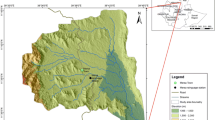Abstract
In the Alexander von Humboldt National Park in eastern Cuba many endemic animals and plants are found in various different natural habitats, which are considered to be the most important ones for in-situ conservation in the entire Insular Caribbean. In some areas of the National Park agriculture is practised. Thus, the objective of this study was to document and analyse the different land use activities and their consequences for local resource management and conservation of biodiversity in two village areas. A particular question was: what has changed since the foundation of the National Park in 1996? As time series data for land use and aerial photographs were not available for this part of Cuba, a qualitative evaluation was carried out. For this, six different land use units were mapped in 2001 and additional information gathered for areas with special interest related to sustainable land use and resource conservation. Although most parts of the study area are influenced to various degrees by human impact, the different types of land use seem presently not to have a crucial or detrimental impact on the land resources of the Alexander von Humboldt National Park. However, exploitation of the natural resources in certain areas could be improved with different management options to reach sustainability as well as to meet the conservation objectives of the National Park. This includes reduced or abandoned agricultural use of steep slopes to reduce erosion risk as well as a facilitated regeneration of natural vegetation in many parts of the study area to be able to conserve the high valuable biodiversity of the Park. Environmental education seems to have played an important and successful role since the foundation of the Park in 1996. Since then, cropping on steep slopes as well as illegal logging and poaching could be reduced.
Similar content being viewed by others
References
Alvarez J., 2000: Differences in agricultural productivity in Cuba's state and nonstate sectors: further evidence. Cuba in Transition, 10: 98–;107.
Bähr J., Mertins G., Nuhn H. & Widderich, S., 1997: Der wirtschaftliche Wandel in Kuba: Reform oder Transformation? Geographische Rundschau, 49(11): 624–;630.
Barthlott W. & Winiger M. (eds), 1998: Biodiversity: a challenge for development research and policy. Springer, Berlin, Heidelberg.
Bender S., 2002: Landnutzung und Umweltbildung im Bereich zweier Schutzgebiete im Osten Kubas. Unpublished master thesis, University of Greifswald, Germany, 113 pp.
Bisse J., 1988: Arboles de Cuba. Editorial Científico-Técnica, Ministerio de Cultura, La Habana, Cuba, 384 pp.
Borhidi A., 1991: Phytogeography and vegetation ecology of Cuba. Akadémiai Kiadó, Budapest, 859 pp.
CNAP, 2001: The Alexander von Humboldt National Park. La Habanna, Cuba, 9 pp.
Deere C.D., 1997: Reforming Cuban agriculture. Development and Change, 28: 649–;669.
Deere C.D., Gonzales E., Pérez N., Rodriguez & G., 1995: Household incomes in Cuban agriculture: a comparison of the state, co-operatives, and peasant sectors. Development and Change, 26: 209–;234.
Esquivel M. & Hammer K. 1992: The Cuban homegarden ‘conuco’: a perspective environment for evolution and in situ conservation of plant genetic resources. Genetic Resources and Crop Evolution, 39: 9–;22.
Gajaseni J. & Gajaseni N. 1999: Ecological rationalities of the traditional homegarden system in the Chao Phraya Basin, Thailand. Agroforestry Systems, 46(1): 3–;24.
Instituto Cuba de Geodesia y Cartografía, 1978: Atlas de Cuba. La Habana, Cuba.
Instituto de Meteorología de la Academia de Ciencias de Cuba, 1987: Atlas climatico de Cuba. 207 pp.
Jensen M., 1993: Productivity and nutrient cycling of a Javanese homegarden. Agroforestry Systems, 24: 187–;201.
Köhler E., 2001: Botanische Aspekte aus dem Nationalpark ‘Alejandro de Humboldt’. Oro Verde Spezial, 8: 15–;19.
Ministerio de la Agricultura, 2001: Manual de trabajo para la atención al sector cooperativo y campesino. La Habana, Cuba.
Murnati, Garrity D.P. & Gintings A.N., 2001: The contribution of agroforestry systems to reducing farmers' dependence on the resources of adjacent national parks: a case study from Sumatra, Indonesia. Agroforestry Systems, 52(3): 171–;183.
Rehm S. & Espig G., 1996: Die Kulturpflanzen der Tropen und Subtropen. Ulmer, Stuttgart, 528 pp.
Torquebiau E., 1992: Are tropical agroforestry homegardens sustainable. Agriculture, Ecosystems and Environment, 41: 189–;207.
UNESCO, December 2001a: Alejandro de Humboldt National Park. http://www.unesco.org/whc/sites/839rev.htm
UNESCO, December 2001b: The World Heritage List. http://www.unesco.org/whc/heritage.htm
Wezel A. & Bender S., 2003: Plant species diversity of homegardens of Cuba and its significance for household food supply. Agroforestry Systems, 57: 39–;49.
Author information
Authors and Affiliations
Rights and permissions
About this article
Cite this article
Wezel, A., Bender, S. Agricultural land use in the coastal area of the Alexander von Humboldt National Park, Cuba and its implication for conservation and sustainability. GeoJournal 57, 241–249 (2002). https://doi.org/10.1023/B:GEJO.0000007190.69067.82
Issue Date:
DOI: https://doi.org/10.1023/B:GEJO.0000007190.69067.82




